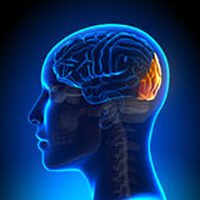 Learn More About This Area Now!
Learn More About This Area Now!
If you hadn’t known already the brain makes up four specific areas or lobes. These lobes include the parietal, frontal, occipital, and temporal lobes. In today’s post we’ll discuss occipital lobe and how its functions specific parts of our body. The location of this part of the brain lies at the bottom and the back part of the cortex. It’s major functions includes responsible for processing visual information from the eyes. Each part of these lobes hold a specific importance to the way our bodies function!
The importance of the occipital lobe is to be able to correctly understand what your eyes are seeing. These lobes have to be very fast to process the rapid information that our eyes are sending. This lobe is similar to the temporal lobe as it makes sense of auditory information, this lobe makes sense of visual information so that we are able to understand it. If this part of the brain becomes impaired or injured we would not be able to correctly process visual signals, thus causing visual confusion and much more. Keep on reading to find out more about this part of the brain now!
What Is The Occipital Lobe?
To refresh your memory, the occipital lobe is located at the rear portion of the skull, behind the parietal and temporal lobes. The most important function that this lobe carries out is the primary visual cortex. This is the region of the brain that receives input from the retina of the eye. This is when the mind interprets color and other important aspects of vision. Pertaining to visual communication this lobe contains different areas. One of these areas is where visual images of language are received and another is where it is interpreted. This part of the brain is also important for reading and reading comprehension.
What Injuries Occur In The Occiptial Lobe?
It’s typically hard to injury this portion of your brain because of the location of the lobe; being in the back of the back, lower part of your brain. When there is any significant damage it could produce subtle changes to our visual-perceptual system. This can result in visual field defects and scotomas. There is a portion of this lobe that is called the peristriate region that is involved in visuospatial processing, discrimination of movement and color discrimination.
Damage to one side of the lobe could cause homonomous loss of vision with exactly the same “field cut” in both eyes. Disorders of the occipital lobe can causes visual hallucinations and illusions. These visual hallucinations can be caused by lesions to the occiptial region or temporal lobe seziures. Distorted perceptions can take the form of objects appearing larger or smaller than they actually are, objects lacking color or objects having abnormal coloring. Lesions in the parietal-temporal-occiptial association area can cause word blindness with writing impairments.
Here is a list of symptoms that you may experience if you’re dealing with any sort of injury in this part of the brain:
- Defects in vision.
- Difficulty with locating objects in environment.
- Difficulty with identifying colors.
- Production of hallucinations.
- Visual Illusions – inaccurately seeing objects.
- Word Blindness – inability to recognize words.
- Difficulty in recognizing drawn objects.
- Inability to recognize the movement of object.
- Difficulties with reading and writing.
If you’re experience any sort of these symptom please visit your doctor pertaining your symptoms.
